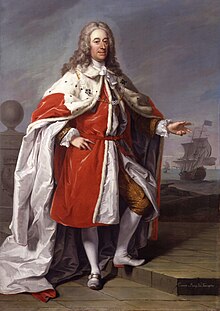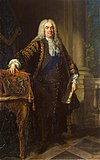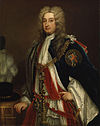George Byng, 1st Viscount Torrington
The Viscount Torrington | |
|---|---|
 Admiral of the Fleet George Byng, 1st Viscount Torrington byJeremiah Davisonin 1733 | |
| Born | 27 January 1663[1] Wrotham,Kent |
| Died | 17 January 1733(aged 69) Southill,Bedfordshire |
| Buried | Church of All Saints, Southill, Bedfordshire |
| Allegiance | |
| Service/ | |
| Years of service | 1678–1733 |
| Rank | Admiral of the Fleet |
| Commands | HMSConstant Warwick HMSHope HMSDuchess HMSRoyal Oak HMSBritannia HMSNassau Mediterranean Fleet |
| Battles/wars | Glorious Revolution Nine Years' War |
| Awards | Knight Companion of the Order of the Bath |

Admiral of the FleetGeorge Byng, 1st Viscount Torrington,KB,PC(27 January 1663 – 17 January 1733), ofSouthill Parkin Bedfordshire, was aRoyal Navyofficer and statesman. While still a lieutenant, he delivered a letter from various captains toPrince William of Orange,who had just landed atTorbay,assuring the Prince of the captains' support; the Prince gave Byng a response which ultimately led to the Royal Navy switching allegiance to the Prince and theGlorious Revolutionof November 1688.
As a captain, Byng saw action at theBattle of Vigo Bay,when the French fleet were defeated, during theWar of the Spanish Succession.As a flag officer, he led the bombardment squadron while serving under AdmiralSir George Rookeat theCapture of Gibraltarand then took part in theBattle of Málagaat a later stage in the same war.
Byng was sent to the Mediterranean to thwart any attempt by the Spanish to takeSicily.He encountered the Spanish fleet atNaplesand, after pursuing it down theStrait of Messina,sent ahead his fastest ships causing the Spanish fleet to split in two. In the ensuing action, known as theBattle of Cape Passaro,the Spanish fleet was devastated: 10 ships of the line were captured, four ships of the line sunk or burnt and four frigates were captured at this early and critical stage of theWar of the Quadruple Alliance.He went on to beFirst Lord of the Admiraltyduring the reign ofKing George II.
Early career
[edit]Born the son of John Byng and Philadelphia Byng (née Johnson), Byng joined theRoyal Navyas aKing's Letter Boyin May 1678.[2]He served initially in thefourth-rateHMSSwallowand then transferred to the fourth-rateHMSReservein November 1678 and to the fourth-rateHMSMary Rosein June 1679.[2]He sailed with thefifth-rateHMSPhoenixtoTangierin Summer 1680 and, after a short period of military service with the2nd Tangier Regiment,he rejoined the Royal Navy as alieutenanton 23 February 1684 and assigned to the fourth-rateHMSOxfordbefore returning to HMSPhoenixin which he sailed to theEast Indieson a mission to put down a rebellion inBombay.[2]He transferred to the fourth-rateHMSMordauntin May 1688 and to thethird-rateHMSDefiancein September 1688.[2]

In October 1688 Byng, still a lieutenant, delivered a letter from various captains toPrince William of Orange,who had just landed atTorbay,assuring the Prince of the captains' support; the Prince gave Byng a response which ultimately led to the Royal Navy switching allegiance to the Prince and theGlorious Revolutionof November 1688.[2]Promoted tocaptainon 22 December 1688, he was given command of the fourth-rateHMSConstant Warwickbefore transferring to the command of the third-rateHMSHopein May 1690 in which he saw action at theBattle of Beachy Headin July 1690 during theNine Years' War.He transferred to the command of thesecond-rateHMSDuchessin September 1690 and to the third-rateHMSRoyal Oakin January 1691 before becoming Flag Captain to AdmiralEdward Russellin thefirst-rateHMSBritanniain December 1693.[2]
Byng was given command of the third-rateHMSNassauin June 1702 and saw action at theBattle of Vigo Bay,when the French fleet were defeated, in October 1702 during theWar of the Spanish Succession.[2]
Senior command
[edit]Promoted torear admiralon 1 March 1703, Byng became third-in-command of theMediterranean Fleetunder AdmiralSir Cloudesley Shovellwith his flag in the third-rateHMSRanelaghlater that month. He led the bombardment squadron while serving under AdmiralSir George Rookeat theCapture of Gibraltarin August 1704 and then took part in theBattle of Málagain August 1704.[2]Knightedon 22 October 1704,[3]and promoted tovice admiralon 3 January 1705, he was electedMember of ParliamentforPlymouthlater that year.[4]
Byng becameCommander-in-Chief, Portsmouth,with his flag in the first-rateHMSRoyal Anne,in late 1705 and then took part in the bombardment ofAlicantein June 1706. After taking part in the British defeat at theBattle of Toulonin July 1707 and, while sailing aboard his flagship HMSRoyal Anne,Byng was present during thegreat naval disaster off the Isles of Scillyin October 1707 when Shovell and four of his ships were lost, claiming the lives of nearly 2,000 sailors.[5]
Promoted to fulladmiralon 26 January 1708, Byng became Commander-in-Chief of the Mediterranean Fleet in January 1709[6]and went on to join theBoard of Admiraltyled by theEarl of Orfordin November 1709.[7]Byng was advanced toSenior Naval Lordon the Admiralty Board in October 1710.[8]He stood down from the Admiralty Board in January 1714 but was reappointed, as Senior Naval Lord again, on Orford's return to the Admiralty in October 1714.[7]

Byng took part in the suppression of theJacobite risingby cutting off theOld Pretender's supplies in 1715 and for this he was created abaroneton 15 November 1715. In 1717 he was commanding theBritish fleet in the Balticwith full cooperation from Denmark's admiral Peter Raben.[9]
He was promoted toAdmiral of the Fleeton 14 March 1718 and, with his flag in the second-rateHMSBarfleur,he was sent out as Commander-in-Chief of the Mediterranean Fleet[10]to thwart any attempt by the Spanish to gain or to consolidate their position inSicily.He encountered the Spanish fleet atNaplesand, after pursuing it down theStrait of Messina,sent ahead his fastest ships causing the Spanish fleet to split in two.[11]In the ensuing action on 11 August 1718, known as theBattle of Cape Passaro,the Spanish fleet was devastated: 10 ships of the line were captured, 4 ships of the line sunk or burnt and 4 frigates were captured at this early and critical stage of theWar of the Quadruple Alliance.[12]

Byng was then given power to negotiate with the various princes and states of Italy on behalf of the English crown.[13]Following his return to England, Byng became bothTreasurer of the Navy[14]andRear-Admiral of Great Britainon 21 October 1720.[15]He was admitted to thePrivy Councilon 3 January 1721[16]and, having stepped down from the Admiralty Board in September 1721,[7]was created Baron Byng of Southill in the county ofBedford,and 1stViscount TorringtoninDevonon 21 September 1721.[17]He developed his estate atSouthill ParkinBedfordshirein the 1720s.[18]
Byng was installed as aKnight Companion of the Order of the Bathon 17 June 1725 and appointedFirst Lord of the Admiraltyduring theWalpole–Townshend Ministryin August 1727; in this role he was instrumental in the establishment of theRoyal Naval CollegeatPortsmouth.[19]
Marriage and progeny
[edit]
Byng was married atSt Paul's, Covent Garden,on 6 March 1691 to Margaret Master, daughter of James Master ofEast Langdonin Kent.[20]Together the couple had fifteen children (eleven sons and four daughters) of whom six lived to survive him:[21][22]
- Pattee Byng(1699–1747), 2nd Viscount Torrington, died without surviving progeny.
- George Byng(1701–1750), 3rd Viscount Torrington
- Robert Byng(1703–1740), Governor of Barbados (1739–1740), from whom theEarls of Straffordstem.
- John Byng(1704–1757), Admiral controversiallycourt-martialledand shot at the outbreak of theSeven Years' Warin Europe.
- Edward Byng (1706–1756)
- Sarah Byng (1695–1775)
Death and burial
[edit]Byng died on 17 January 1733 and was eventually buried in a vault within the newly constructedByng Mausoleumattached to the north side of the Church of All Saints in the parish ofSouthill,Bedfordshire,[23]in which parish was situated his residence ofSouthill Park.The mausoleum was constructed for his burial, with licence granted by theBishop of Lincolnin 1733.[24]
References
[edit]Citations
[edit]- ^G. E. Cokayne; with Vicary Gibbs, H.A. Doubleday, Geoffrey H. White, Duncan Warr and Lord Howard de Walden, editors, The Complete Peerage of England, Scotland, Ireland, Great Britain and the United Kingdom, Extant, Extinct or Dormant, Gloucester, U.K.: Alan Sutton Publishing, 2000), volume XII/1, page 789
- ^abcdefghHattendorf, John B. "Byng, George, first Viscount Torrington".Oxford Dictionary of National Biography(online ed.). Oxford University Press.doi:10.1093/ref:odnb/4262.(Subscription orUK public library membershiprequired.)
- ^"No. 4064".The London Gazette.19 October 1704. p. 4.
- ^Matthews, Shirley (1970)."Byng, Sir George".InSedgwick, Romney(ed.).The House of Commons 1715–1754.The History of Parliament Trust.Retrieved16 May2015.
- ^Sobel, p. 6.
- ^Owen, John Hely (2010).War at Sea Under Queen Anne 1702–1708.Cambridge, England: Cambridge University Press. p. 100.ISBN9781108013383.
- ^abcSainty, J. C. (1975).Lord High Admiral and Commissioners of the Admiralty 1660–1870, Office-Holders in Modern Britain: Volume 4: Admiralty Officials 1660–1870.pp. 18–31. Archived fromthe originalon 7 October 2014.Retrieved16 May2015.
- ^Rodger, pp. 51–52.
- ^Topsøe-Jensen, Vol 2, p. 344.
- ^Harrison, Simon (2010–2018)."George Byng (1663/64-1732/33)".threedecks.org.S. Harrison.Retrieved7 January2019.
- ^"The Battles of George Byng".Retrieved16 May2015.
- ^Bodart, p. 176.
- ^"No. 5882".The London Gazette.30 August 1720. p. 1.
- ^Sainty, J. C."Navy Treasurer c. 1546–1836".Institute of Historical Research.Retrieved16 May2015.
- ^"No. 5896".The London Gazette.18 October 1720. p. 1.
- ^"No. 5917".The London Gazette.31 December 1720. p. 1.
- ^"No. 5988".The London Gazette.5 September 1721. p. 1.
- ^"Southill Park".Bedfordshire County Council. Archived fromthe originalon 2 May 2015.Retrieved16 May2015.
- ^Chisholm, Hugh,ed. (1911)..Encyclopædia Britannica.Vol. 27 (11th ed.). Cambridge University Press.
- ^Cokayne, George Edward(1896).The Complete Peerage.London: George Bell & Sons. p. 410.
- ^Debrett, John (1840).Debrett's Peerage of England, Scotland, and Ireland.London: William Pickering. pp.728–729.
peerage.
- ^"George Byng, 1st Viscount Torrington".Cracrofts Peerage.Retrieved16 May2015.
- ^"Byng vault".The Mausolea and Monuments Trust. Archived fromthe originalon 18 May 2015.Retrieved16 May2015.
- ^dijit.net."Byng Vault – Mausolea & Monuments Trust".Mmtrust.org.uk. Archived fromthe originalon 18 May 2015.Retrieved17 April2018.
Sources
[edit]- Bodart, Gaston (1908).Militär-historisches Kriegs-Lexikon, (1618–1905).Vienna.
{{cite book}}:CS1 maint: location missing publisher (link) - Rodger, N. A. M.(1979).The Admiralty. Offices of State.Lavenham:T. Dalton Ltd.ISBN0900963948.
- Sobel, Dava(1998).Longitude: The True Story of a Lone Genius Who Solved the Greatest Scientific Problem of His Time.London: Fourth Estate.ISBN1-85702-571-7.
- Laughton, John Knox (1886)..InStephen, Leslie(ed.).Dictionary of National Biography.Vol. 8. London: Smith, Elder & Co.
- Chisholm, Hugh,ed. (1911)..Encyclopædia Britannica.Vol. 27 (11th ed.). Cambridge University Press.
Further reading
[edit]- Byng, George, Sir (1739).Account of the Expedition of the British Fleet to Sicily, In the Years 1718, 1719, and 1720.J. and R. Tonson.
{{cite book}}:CS1 maint: multiple names: authors list (link)
External links
[edit]- George Byng (1663/64-1732/33)Three Decks
- Hutchinson, John (1892)..Men of Kent and Kentishmen(Subscription ed.). Canterbury: Cross & Jackman. p. 28.
- 1663 births
- 1733 deaths
- People from Wrotham
- Royal Navy admirals of the fleet
- Lords of the Admiralty
- Viscounts in the Peerage of Great Britain
- Knights Companion of the Order of the Bath
- Members of the Privy Council of Great Britain
- British naval commanders in the War of the Spanish Succession
- English MPs 1705–1707
- Members of the Parliament of Great Britain for Plymouth
- British MPs 1707–1708
- British MPs 1708–1710
- British MPs 1710–1713
- British MPs 1713–1715
- British MPs 1715–1722
- 18th-century Royal Navy personnel
- Byng family
- Soldiers of the Tangier Garrison
- People from Southill, Bedfordshire
- Members of the Parliament of England for Plymouth
- British military personnel of the War of the Quadruple Alliance




